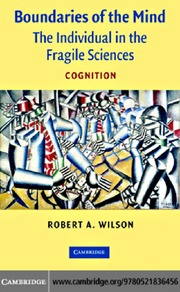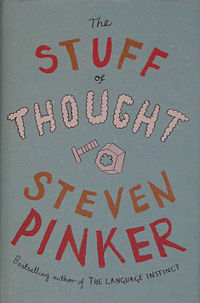 W
WThe Age of Intelligent Machines is a non-fiction book about artificial intelligence by inventor and futurist Ray Kurzweil. This was his first book and the Association of American Publishers named it the Most Outstanding Computer Science Book of 1990. It was reviewed in The New York Times and The Christian Science Monitor. The format is a combination of monograph and anthology with contributed essays by artificial intelligence experts such as Daniel Dennett, Douglas Hofstadter, and Marvin Minsky.
 W
WThe Age of Spiritual Machines: When Computers Exceed Human Intelligence is a non-fiction book by inventor and futurist Ray Kurzweil about artificial intelligence and the future course of humanity. First published in hardcover on January 1, 1999 by Viking, it has received attention from The New York Times, The New York Review of Books and The Atlantic. In the book Kurzweil outlines his vision for how technology will progress during the 21st century.
 W
WThe Art of Thinking Clearly is a 2013 book by the Swiss writer Rolf Dobelli which describes in short chapters 99 of the most common thinking errors - ranging from cognitive biases to envy and social distortions.
 W
WBoundaries of the Mind (2004) is a thorough treatment of the role and conceptualization of the individual in psychology, by author Robert A. Wilson, a professor in the Department of Philosophy at the University of Alberta.
 W
WThe Design of Everyday Things is a best-selling book by cognitive scientist and usability engineer Donald Norman about how design serves as the communication between object and user, and how to optimize that conduit of communication in order to make the experience of using the object pleasurable. One of the main premises of the book is that although people are often keen to blame themselves when objects appear to malfunction, it is not the fault of the user but rather the lack of intuitive guidance that should be present in the design.
 W
WA History of the Mind: Evolution and the Birth of Consciousness is a 1992 book about the mind–body problem by the psychologist Nicholas Humphrey. Humphrey advances a hypothesis about consciousness that has been criticised as speculative.
 W
WHow the Mind Works is a 1997 book by the Canadian-American cognitive scientist Steven Pinker, in which the author attempts to explain some of the human mind's poorly understood functions and quirks in evolutionary terms. Drawing heavily on the paradigm of evolutionary psychology articulated by John Tooby and Leda Cosmides, Pinker covers subjects such as vision, emotion, feminism, and "the meaning of life". He argues for both a computational theory of mind and a neo-Darwinist / adaptationist approach to evolution, all of which he sees as the central components of evolutionary psychology. He criticizes difference feminism because he believes scientific research has shown that women and men differ little or not at all in their moral reasoning. The book was a Pulitzer Prize Finalist.
 W
WHow to Create a Mind: The Secret of Human Thought Revealed is a non-fiction book about brains, both human and artificial, by the inventor and futurist Ray Kurzweil. First published in hardcover on November 13, 2012 by Viking Press it became a New York Times Best Seller. It has received attention from The Washington Post, The New York Times and The New Yorker.
 W
WIncomplete Nature: How Mind Emerged from Matter is a 2011 book by biological anthropologist Terrence Deacon. The book covers topics in biosemiotics, philosophy of mind, and the origins of life. Broadly, the book seeks to naturalistically explain "aboutness", that is, concepts like intentionality, meaning, normativity, purpose, and function; which Deacon groups together and labels as ententional phenomena.
 W
WThe book The Mechanism of Mind by Edward de Bono details the underpinning model of mind that leads to the many thinking skills developed by its author, including lateral thinking.
 W
WMistakes Were Made is a non-fiction book by social psychologists Carol Tavris and Elliot Aronson, first published in 2007. It deals with cognitive dissonance, confirmation bias and other cognitive biases, using these psychological theories to illustrate how the perpetrators of hurtful acts justify and rationalize their behavior. It describes a positive feedback loop of action and self-deception by which slight differences between people's attitudes become polarized.
 W
WMoral Politics: How Liberals and Conservatives Think is a 1996 book by cognitive linguist George Lakoff. It argues that conservatives and liberals hold two different conceptual models of morality. Conservatives have a strict father model in which people are made good through self-discipline and hard work, everyone is taken care of by taking care of themselves. Liberals have a nurturant parent model in which everyone is taken care of by helping each other.
 W
WThe Organized Mind: Thinking Straight in the Age of Information Overload is a bestselling popular science book written by the McGill University neuroscientist Daniel J. Levitin, PhD, and first published by Dutton Penguin in the United States and Canada in 2014. It is Levitin's 3rd consecutive best-seller, debuting at #2 on the New York Times Best Seller List, #1 on the Canadian best-seller lists, #1 on Amazon, and #5 on The London Times bestseller list.
 W
WThe Stuff of Thought: Language As a Window Into Human Nature is a 2007 book by experimental psychologist Steven Pinker. In the book Pinker "analyzes how our words relate to thoughts and to the world around us and reveals what this tells us about ourselves". Put another way, Pinker "probes the mystery of human nature by examining how we use words". The book became a New York Times best seller.
 W
WThe Symbolic Species is a 1997 book by biological anthropologist Terrence Deacon on the evolution of language. Combining perspectives from neurobiology, evolutionary theory, linguistics, and semiotics, Deacon proposes that language, along with the unique human capacity for symbolic thought, co-evolved with the brain.
 W
WThis Is Your Brain on Music: The Science of a Human Obsession is a popular science book written by the McGill University neuroscientist Daniel J. Levitin, and first published by Dutton Penguin in the U.S. and Canada in 2006, and updated and released in paperback by Plume/Penguin in 2007. It has been translated into 18 languages and spent more than a year on The New York Times, The Globe and Mail, and other bestseller lists, and sold more than one million copies.
 W
WThe World in Six Songs: How the Musical Brain Created Human Nature is a popular science book written by the McGill University neuroscientist Daniel J. Levitin, and first published by Dutton Penguin in the U.S. and Canada in 2008, and updated and released in paperback by Plume in 2009, and translated into six languages. Levitin’s second New York Times bestseller, following the publication of This Is Your Brain on Music, received praise from a wide variety of readers including Sir George Martin, Sting, Elizabeth Gilbert, and Adam Gopnik. The Los Angeles Times called it "masterful". The New York Times wrote: "A lively, ambitious new book whose combined elements can induce feelings of enlightenment and euphoria. Will leave you awestruck." The Times wrote "Levitin is such an enthusiastic anthropologist, such an exuberant song and dance man, such a natural-born associative thinker, that you gotta love the guy." It was named one of the best books of 2008 by the Boston Herald and by Seed Magazine.